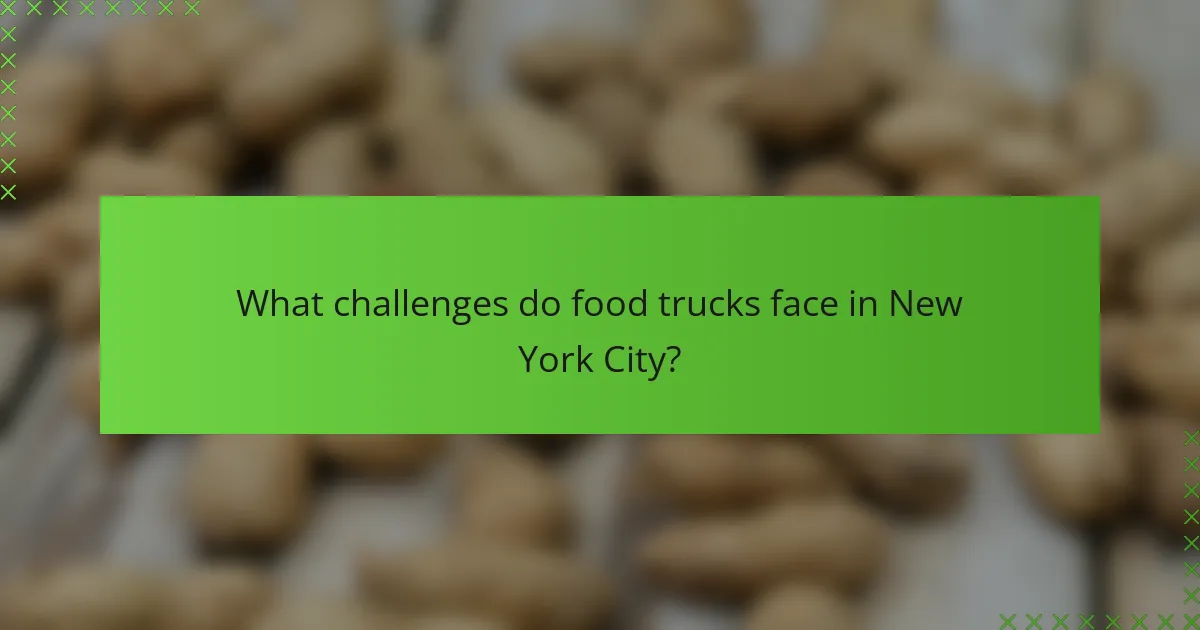
What are the key influences of New York’s food trucks on the culinary landscape?
New York’s food trucks significantly influence the culinary landscape by introducing diverse cuisines. They offer accessible, affordable meals that cater to a wide range of tastes. The presence of food trucks encourages culinary innovation and experimentation. Many chefs use food trucks to test new concepts before opening brick-and-mortar restaurants. Food trucks also contribute to the vibrant street food culture in New York City. They create a sense of community and bring people together over shared culinary experiences. The popularity of food trucks has inspired local regulations to ensure food safety and fair competition. These influences shape dining trends and reflect the evolving tastes of New Yorkers.
How have food trucks shaped culinary trends in New York City?
Food trucks have significantly shaped culinary trends in New York City by introducing diverse global cuisines. They have popularized street food, making it accessible to a wider audience. This shift has encouraged chefs to experiment with fusion dishes. Food trucks often feature seasonal and locally sourced ingredients. Their mobility allows them to respond quickly to changing food trends. Data from the NYC Department of Health shows a rise in food truck permits, reflecting their popularity. They have also fostered a competitive environment, pushing restaurants to innovate. Overall, food trucks have transformed the city’s culinary landscape, making it more vibrant and diverse.
What innovative cuisines have emerged from New York’s food truck scene?
Innovative cuisines that have emerged from New York’s food truck scene include Korean tacos and gourmet grilled cheese. Korean tacos blend traditional Korean flavors with Mexican street food. This fusion gained popularity through trucks like Kogi BBQ. Gourmet grilled cheese trucks offer artisanal takes on the classic sandwich. They often feature unique cheeses and gourmet toppings. Additionally, vegan and plant-based options have surged, catering to health-conscious consumers. Food trucks like The Cinnamon Snail showcase creative vegan dishes. The diverse food truck landscape reflects New York’s multicultural environment. This has led to a vibrant culinary scene that continually evolves.
How do food trucks reflect the cultural diversity of New York City?
Food trucks in New York City showcase the city’s cultural diversity through their varied cuisines. They offer a wide range of food options representing different cultures. Popular offerings include tacos, falafel, dumplings, and halal food. Each type of food truck reflects the heritage of its cuisine. For instance, Mexican food trucks highlight traditional recipes and flavors. Similarly, Middle Eastern trucks serve dishes like shawarma and kebabs. This variety allows residents and tourists to experience global flavors in one city. The presence of these trucks fosters cultural exchange and community engagement. Food trucks have become a symbol of New York’s multicultural identity.
What role do food trucks play in the local economy?
Food trucks significantly contribute to the local economy by creating jobs and generating revenue. They offer employment opportunities for chefs, drivers, and support staff. Food trucks also stimulate local spending by attracting customers to specific areas. According to a report by the Street Vendor Project, food trucks in New York City generate over $200 million annually. This revenue supports local suppliers and food producers. Additionally, food trucks enhance tourism by providing unique culinary experiences. They help diversify the local food scene, catering to various tastes and preferences. Overall, food trucks play a vital role in enhancing economic activity within their communities.
How do food trucks create job opportunities in New York?
Food trucks create job opportunities in New York by providing flexible employment options. They hire chefs, cooks, and kitchen staff, contributing to the culinary workforce. Additionally, food trucks often need drivers and operators to manage logistics. This model allows for a lower barrier to entry for entrepreneurs. Many food truck owners start small businesses, generating local employment. An estimated 15,000 food trucks operate in New York City, contributing significantly to the economy. These trucks also stimulate related sectors, such as food supply and event planning. Overall, food trucks play a vital role in job creation within the city.
What is the economic impact of food trucks on traditional restaurants?
Food trucks can negatively impact traditional restaurants economically. They often attract customers away from brick-and-mortar establishments. A study by the National Restaurant Association indicates that food trucks can decrease foot traffic for nearby restaurants. This competition can lead to reduced sales for traditional dining options. Additionally, food trucks typically have lower operating costs. They can offer lower prices, making them more appealing to budget-conscious consumers. In urban areas, the presence of food trucks can shift the dining landscape. This shift can force traditional restaurants to adapt their business models to maintain profitability.
How do city regulations affect food trucks in New York?
City regulations significantly impact food trucks in New York. These regulations dictate where food trucks can operate. They often require permits, which can be costly and time-consuming to obtain. Specific zones may restrict food truck locations to avoid congestion. Compliance with health and safety standards is mandatory for all food trucks. Violations can lead to fines or the revocation of permits. Additionally, regulations may limit operating hours in certain areas. This affects the overall business strategy of food truck operators. The city’s regulatory framework aims to balance public safety and urban mobility with the interests of food vendors.
What specific permits are required to operate a food truck in New York City?
To operate a food truck in New York City, specific permits are required. The primary permit is the Mobile Food Vendor License, issued by the NYC Department of Health and Mental Hygiene. Additionally, vendors must obtain a Food Service Establishment Permit. Another requirement is a City-issued Street Vendor License. Food trucks must also have a valid vehicle registration and insurance. Compliance with the NYC Fire Department regulations is necessary for cooking equipment. These permits ensure that food trucks meet health and safety standards.
How do zoning laws influence food truck locations?
Zoning laws significantly influence food truck locations by dictating where they can operate. These regulations establish designated areas for commercial activities, including food vending. In New York City, specific zoning districts allow food trucks in certain locations while prohibiting them in others. For example, food trucks are often restricted from operating near schools, hospitals, and residential areas. Compliance with these laws is essential for food truck operators to avoid fines or business shutdowns. Additionally, some neighborhoods may have stricter regulations, impacting the availability of prime locations. Understanding these zoning laws is crucial for food truck owners to maximize their business potential.

What are the most popular offerings from New York’s food trucks?
New York’s food trucks primarily offer diverse and popular items such as tacos, gourmet sandwiches, and falafel. Tacos are favored for their convenience and variety, often filled with meats, vegetables, or fusion ingredients. Gourmet sandwiches feature high-quality ingredients and unique flavor combinations, attracting a wide range of customers. Falafel stands out as a popular vegetarian option, known for its flavor and texture. Additionally, food trucks frequently serve hot dogs, a classic New York street food, and ethnic cuisines reflecting the city’s multicultural landscape. These offerings are consistently popular due to their accessibility and the vibrant culinary scene in New York.
What types of cuisines are most commonly found in New York food trucks?
New York food trucks commonly offer a diverse range of cuisines. Popular options include Mexican, with tacos and burritos frequently served. Asian cuisines, such as Korean and Chinese, are also prevalent, featuring dishes like bibimbap and dumplings. Middle Eastern cuisine is represented by offerings like falafel and shawarma. American classics, including hot dogs and burgers, are staples as well. Additionally, there is an increasing presence of gourmet and fusion food trucks. These trucks combine elements from various culinary traditions, reflecting the city’s multicultural landscape. The variety in food truck offerings caters to a wide array of tastes and preferences.
How do seasonal ingredients influence food truck menus?
Seasonal ingredients significantly influence food truck menus by dictating the availability and variety of dishes. Food trucks often adapt their offerings to reflect seasonal produce, ensuring freshness and flavor. For instance, summer months may see an increase in fruit-based items, while winter can lead to heartier, warming dishes. This approach not only enhances taste but also appeals to consumer preferences for local and seasonal foods. A study by the Culinary Institute of America found that 70% of consumers prefer meals made with seasonal ingredients. Consequently, food trucks that prioritize these ingredients can attract more customers and foster loyalty. Seasonal menus also allow food trucks to differentiate themselves from competitors by showcasing unique and timely dishes.
Which food truck dishes have gained iconic status in New York?
The food truck dishes that have gained iconic status in New York include the halal cart chicken over rice, lobster rolls, and the classic New York-style hot dog. Halal chicken over rice is famous for its flavorful spiced chicken served with rice and salad, often accompanied by white sauce and hot sauce. The lobster roll, popularized by several gourmet food trucks, features fresh lobster meat in a buttery roll. New York-style hot dogs, typically served with mustard and sauerkraut, are a staple found at numerous food trucks throughout the city. These dishes reflect the diverse culinary landscape of New York and have become synonymous with the city’s street food culture.
What are the customer preferences when it comes to food trucks?
Customers prefer diverse food options from food trucks. They enjoy unique and gourmet offerings over standard fast food. Fresh ingredients and quality preparation are highly valued. Convenience and accessibility are significant factors in their choices. Many customers appreciate the ability to try international cuisines. The social aspect of dining at food trucks is also important. Customers often seek food trucks with a strong brand identity. Reviews and social media presence influence their decisions.
How do food truck patrons choose their meals?
Food truck patrons choose their meals based on several factors. These factors include menu variety, visual appeal, and aroma. Patrons often consider the popularity of specific food trucks. They may look for long lines as an indicator of quality. Social media presence can also influence meal choices. Many patrons rely on reviews and recommendations from friends. Seasonal ingredients and unique offerings attract attention. Additionally, dietary preferences play a significant role in decision-making.
What factors contribute to the popularity of specific food trucks?
The popularity of specific food trucks is influenced by several key factors. First, the quality of food plays a crucial role. High-quality ingredients and unique recipes attract customers. Second, location is vital. Food trucks positioned in high-traffic areas tend to draw larger crowds. Third, social media presence enhances visibility. Active engagement on platforms like Instagram can increase customer interest. Fourth, customer service impacts repeat business. Friendly and efficient service encourages positive word-of-mouth. Fifth, menu diversity appeals to various tastes. Offering vegetarian, vegan, or gluten-free options can attract a broader audience. Lastly, branding and aesthetics matter. A visually appealing truck can entice customers to stop and explore the menu. These factors collectively contribute to the sustained popularity of specific food trucks.
How do food trucks adapt to changing culinary trends?
Food trucks adapt to changing culinary trends by evolving their menus and incorporating popular ingredients. They frequently survey customer preferences and analyze market trends. This allows them to introduce new dishes that reflect current food movements, such as plant-based options or global cuisines. Seasonal ingredients are often featured to align with consumer demand for freshness. Additionally, food trucks leverage social media to gauge interest in trending items. They can quickly modify their offerings based on immediate feedback. This flexibility helps them stay competitive in a dynamic food landscape. According to a report by IBISWorld, the food truck industry has seen a 7.5% annual growth, indicating successful adaptation to trends.
What innovations have food trucks implemented to stay relevant?
Food trucks have implemented various innovations to stay relevant in a competitive market. They have adopted advanced technology for online ordering and payment systems. Many food trucks now utilize social media for real-time location updates and menu changes. Some have integrated eco-friendly practices, such as using biodegradable packaging. Others offer diverse and gourmet menu options to attract a wider customer base. Additionally, food trucks have partnered with local businesses for special events and collaborations. These strategies help them engage with communities and enhance customer experience. The adoption of mobile apps for loyalty programs has also increased customer retention. These innovations reflect the evolving demands of consumers and the food industry.
How do food trucks incorporate feedback from their customers?
Food trucks incorporate feedback from their customers through direct communication and social media engagement. They often encourage customers to share their opinions verbally at the truck or through comment cards. Many food trucks utilize social media platforms to gather feedback and interact with their audience. They analyze online reviews and comments to identify trends and areas for improvement. Additionally, some food trucks conduct surveys to gain deeper insights into customer preferences. This feedback helps them adjust their menu offerings and improve customer service. For example, a food truck may notice a high demand for vegetarian options and respond by adding more plant-based dishes. Incorporating customer feedback leads to better customer satisfaction and loyalty.

What challenges do food trucks face in New York City?
Food trucks in New York City face several challenges. One major challenge is strict regulations. Food trucks must comply with city health codes and zoning laws. These regulations can limit where trucks can operate. Another challenge is competition for prime locations. High foot traffic areas are often saturated with other food vendors. Additionally, parking restrictions create logistical issues. Trucks may struggle to find legal parking spots during peak hours. Weather conditions also impact operations. Rain or extreme temperatures can reduce customer turnout. Lastly, rising costs of permits and licenses can strain budgets. These factors collectively hinder the success of food trucks in the city.
What are the common operational challenges for food truck owners?
Food truck owners face several common operational challenges. These include navigating city regulations and obtaining necessary permits. Limited parking options can hinder access to high-traffic locations. Food safety compliance is essential and can be complex. Additionally, managing inventory and food waste is critical for profitability. Staffing issues, including hiring and training, present ongoing difficulties. Seasonal fluctuations in customer demand can affect revenue stability. Competition from other food vendors increases operational pressure. Lastly, maintenance and repair of the food truck itself can incur significant costs.
How do weather conditions impact food truck sales?
Weather conditions significantly impact food truck sales. Warm and sunny weather typically increases foot traffic, leading to higher sales. In contrast, rainy or cold weather can deter customers from dining outdoors. A study by the University of California found that food truck sales drop by 30% on rainy days. Additionally, extreme temperatures can also affect customer turnout. For instance, sales may decline during heatwaves as people seek air-conditioned environments. Overall, favorable weather conditions create a more inviting atmosphere for food truck patrons.
What are the logistical hurdles in sourcing ingredients for food trucks?
Food trucks face several logistical hurdles in sourcing ingredients. Limited storage space restricts the amount of inventory they can hold. This limitation often leads to frequent trips to suppliers. Consistent quality and freshness of ingredients are crucial for food trucks. Variability in supply can affect menu offerings and customer satisfaction. Additionally, food trucks must comply with local regulations and health codes. These regulations can complicate sourcing, especially for perishable items. Transportation challenges arise due to traffic and parking restrictions in urban areas. These factors can delay deliveries and impact operations. Overall, food trucks must navigate a complex supply chain to ensure they meet customer demands effectively.
How do food trucks navigate competition in a crowded market?
Food trucks navigate competition in a crowded market by differentiating their offerings. They often focus on unique menu items that are not widely available. This approach attracts customers looking for new culinary experiences. Additionally, food trucks utilize social media for marketing and location updates. Engaging with customers online helps build a loyal following. Many food trucks also participate in local events and festivals to increase visibility. This strategy allows them to reach a broader audience. Offering quality food and excellent customer service further enhances their competitive edge. According to a 2021 report by the National Food Truck Association, food trucks that innovate and engage effectively see higher customer retention rates.
What strategies do successful food trucks use to stand out?
Successful food trucks use unique branding, diverse menus, and social media engagement to stand out. Unique branding includes eye-catching designs and memorable names that attract customers. Diverse menus offer a mix of traditional and innovative dishes, catering to various tastes. Social media engagement allows food trucks to connect with their audience and announce locations in real-time. This strategy builds a loyal customer base. According to a study by the National Food Truck Association, 70% of food truck customers follow their favorite trucks on social media. This demonstrates the effectiveness of social media in enhancing visibility and engagement.
How does social media influence food truck visibility and customer engagement?
Social media significantly enhances food truck visibility and customer engagement. Platforms like Instagram and Facebook allow food trucks to showcase their offerings visually. High-quality photos of food attract potential customers. Social media also facilitates real-time updates on locations and menu changes. This immediacy keeps followers informed and engaged. Additionally, customer reviews and interactions on these platforms build community and trust. According to a survey by the National Restaurant Association, 70% of consumers are influenced by social media when choosing dining options. This statistic underscores the importance of social media for food trucks in capturing customer interest and driving foot traffic.
What best practices can food truck operators implement for success?
Food truck operators can implement several best practices for success. First, they should focus on a unique menu that stands out. This differentiation attracts customers and encourages repeat business. Second, maintaining high food quality is crucial. Consistent quality leads to positive reviews and customer loyalty. Third, effective marketing strategies are essential. Utilizing social media platforms increases visibility and engagement. Fourth, understanding local regulations is important. Compliance with health codes and permits prevents legal issues. Fifth, optimizing location choices can enhance foot traffic. Popular areas increase customer access and sales potential. Sixth, providing excellent customer service improves customer experience. Satisfied customers are more likely to return and recommend the business. Lastly, gathering customer feedback helps refine offerings. This responsiveness to customer preferences fosters loyalty and growth.
How can food trucks effectively market themselves to attract customers?
Food trucks can effectively market themselves by utilizing social media platforms. Engaging content on platforms like Instagram and Facebook increases visibility. Regular updates about menu items and locations attract followers. Collaborating with local influencers can expand their reach. Unique branding and eye-catching designs on the truck create memorable impressions. Offering promotions or discounts can incentivize first-time customers. Participating in local events or festivals increases foot traffic. According to a 2020 survey, 70% of food truck customers follow trucks on social media for updates.
What are the key financial tips for running a successful food truck business?
Key financial tips for running a successful food truck business include careful budgeting, tracking expenses, and managing cash flow. Establish a detailed budget that covers all operational costs, including permits, ingredients, and maintenance. Regularly track expenses to identify areas for cost reduction. Implement a cash flow management system to ensure timely payments and avoid shortages. Set competitive pricing based on market research while considering food costs and profit margins. Monitor sales data to adjust inventory and reduce waste. Utilize effective marketing strategies to attract customers and increase revenue. These practices enhance financial stability and support long-term success in the food truck industry.
The primary entity of this article is New York’s food trucks, which play a significant role in shaping the city’s culinary landscape. The article explores the diverse cuisines offered by food trucks, their impact on culinary trends, and the economic contributions they make to the local community. It also examines the challenges food truck operators face, including city regulations, competition, and sourcing ingredients. Key topics include popular food offerings, customer preferences, and strategies for success in the competitive food truck market. Overall, the article provides a comprehensive overview of the influence of food trucks on New York’s dining culture and economy.
